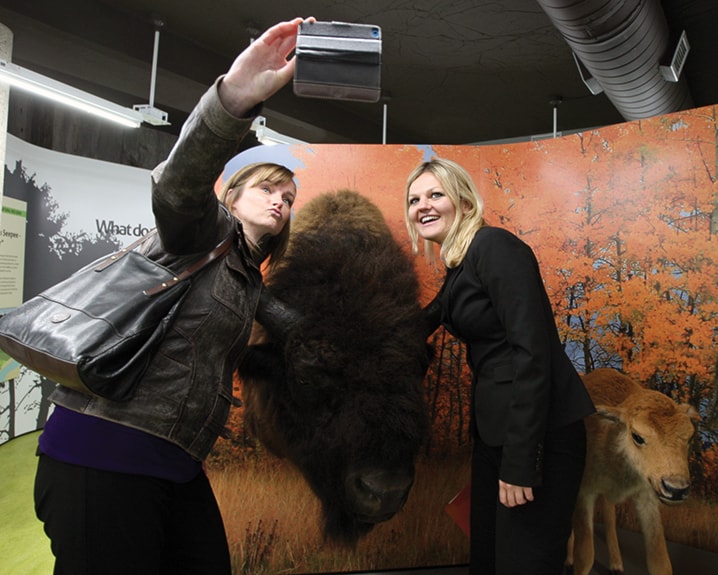A completely revamped Fort Normandeau Interpretive Centre opens to the public at noon today for the season after a year of renovations.
Set off by a striking lime green colour scheme, bright lighting and an entirely new layout of exhibits and artifacts, the centre boasts a more interactive experience for visitors.
“It’s finally all come together and we’re quite proud of the result,” said Jim Robertson, executive director of the Waskasoo Environmental Education Society, which runs the fort. “Basically everything is new. There is nothing left from the old interpretive centre. It was a dark, dingy, not terribly exciting place. This is nice and bright and light and there is all sort of stuff to touch and play with.”
Around $1 million, half from the federal government and half from the City of Red Deer, went towards new exhibits, interpretive signs and an outdoor gathering space and picnic shelter — all to celebrate Red Deer’s centennial last year.
Fort Normandeau is the site of the Red Deer Crossing, the first trading community established in the early 1880s. It eventually moved to the city’s current location after the railway came through. For longer than anyone can remember, the site was also used as a crossing by the Cree, Assiniboine and Blackfoot Confederacy, and later by Métis. It is, as the society says, the place where Red Deer’s story begins.
“Fort Normandeau is such an essential part of our Waskasoo park trail system and we’re just so pleased we’re able to revitalize the exhibits and commemorate our region’s rich history and interpret the past in a manner it is more deserving of,” said Mayor Tara Veer at a ribbon-cutting ceremony at the centre on Friday.
Staff worked closely in consultation with local elders from the First Nations community, as well as the Truth and Reconciliation Commission and members of the Remembering the Children Society to include more cultural representation in the exhibits and redesign the residential school component.
The Red Deer Industrial School, in operation from 1893 to 1919, was located across the Red Deer River, almost directly opposite the fort. Outdoors, there now stands a new telescope-like tool that shows where the school would have stood and what it looked like.
Charles Wood, a Cree elder from Saddle Lake and chair of the Remembering the Children Society, said the new centre is “fabulous.”
“We’re happy and pleased to have been invited to collaborate with the project and I think it’s really well put together,” Wood said. “I am hopeful that the gathering place outside for First Nations gatherings, that they will spread to the wider community and everyone will come together.”
Other interactive elements in the centre include games, a reproduced uniform from the 65th Mount Royal Rifles to try on, a theatre room for a newly produced film, and a bison exhibit where visitors can touch real horn, bone, rawhide and a bladder from the animals.
There is also a life-size replica of the late 19th century general store that stood at the Crossing, allowing visitors the opportunity to play shopkeeper and see how the first settlers purchased goods.
Stories about settlers and the fort never before told are now also available to the public, such as details about Mrs. Eliza Diamond, the wife of a staff sergeant who gave birth to her son in 1889 at the fort — the only baby known to have been born at Fort Normandeau. Another story tells about Insp. Thomas Wellington Chalmers, who kept a wild goose as a pet and fed it oatmeal.
“This will get people so much more engaged,” said Kathryn Huedepohl with the society. “And it really married a more modern look to the historic content, like the surveying equipment, in a great way. ... It’s a hands-on, happy, welcoming place.”
